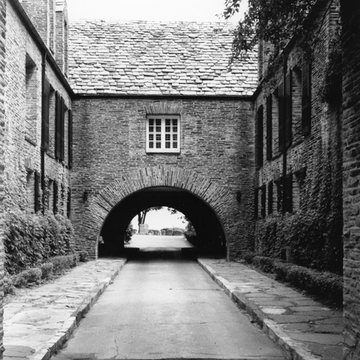This complex perfectly evokes the architecture and expansive spirit of the 1920s. On an inspiring site high above a wide bend in the Allegheny River, Benno Janssen created a miniature English-style Cotswold village of exquisite plan, profile, and materials for this golf club. The clubhouse rests between two hills, and its second story is carried via bridges, which allows automobiles to pass under the structure as it frames glimpses of the Allegheny River valley beyond. Though this picturesque device is certainly not restricted to Pittsburgh buildings, it had specific Pittsburgh precedents in H. H. Richardson's courthouse ( AL1; the two arched entrances there were filled in around 1924) and in Henry Hornbostel's Carnegie Mellon campus ( AL43). The bridges at Longue Vue allowed Janssen to skew the axes of his building and to compartmentalize its functions. They also work well with the timelessness expressed by the club's hand-hewn sandstone walls and high-pitched slate roofs. The golf course was designed by Scottish golf course architect Robert White.
You are here
Longue Vue Club
1921–1923, Janssen and Cocken, Albert D. Taylor, landscape architect. 400 Longue Vue Dr., Penn Hills
If SAH Archipedia has been useful to you, please consider supporting it.
SAH Archipedia tells the story of the United States through its buildings, landscapes, and cities. This freely available resource empowers the public with authoritative knowledge that deepens their understanding and appreciation of the built environment. But the Society of Architectural Historians, which created SAH Archipedia with University of Virginia Press, needs your support to maintain the high-caliber research, writing, photography, cartography, editing, design, and programming that make SAH Archipedia a trusted online resource available to all who value the history of place, heritage tourism, and learning.


